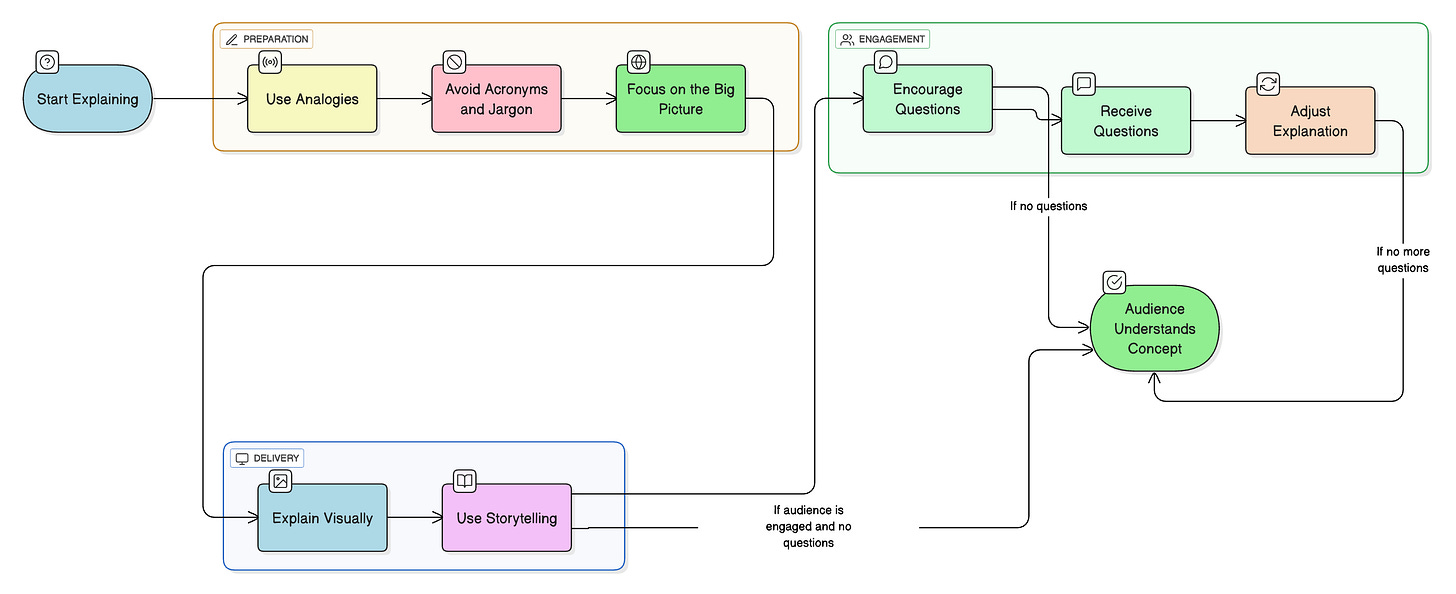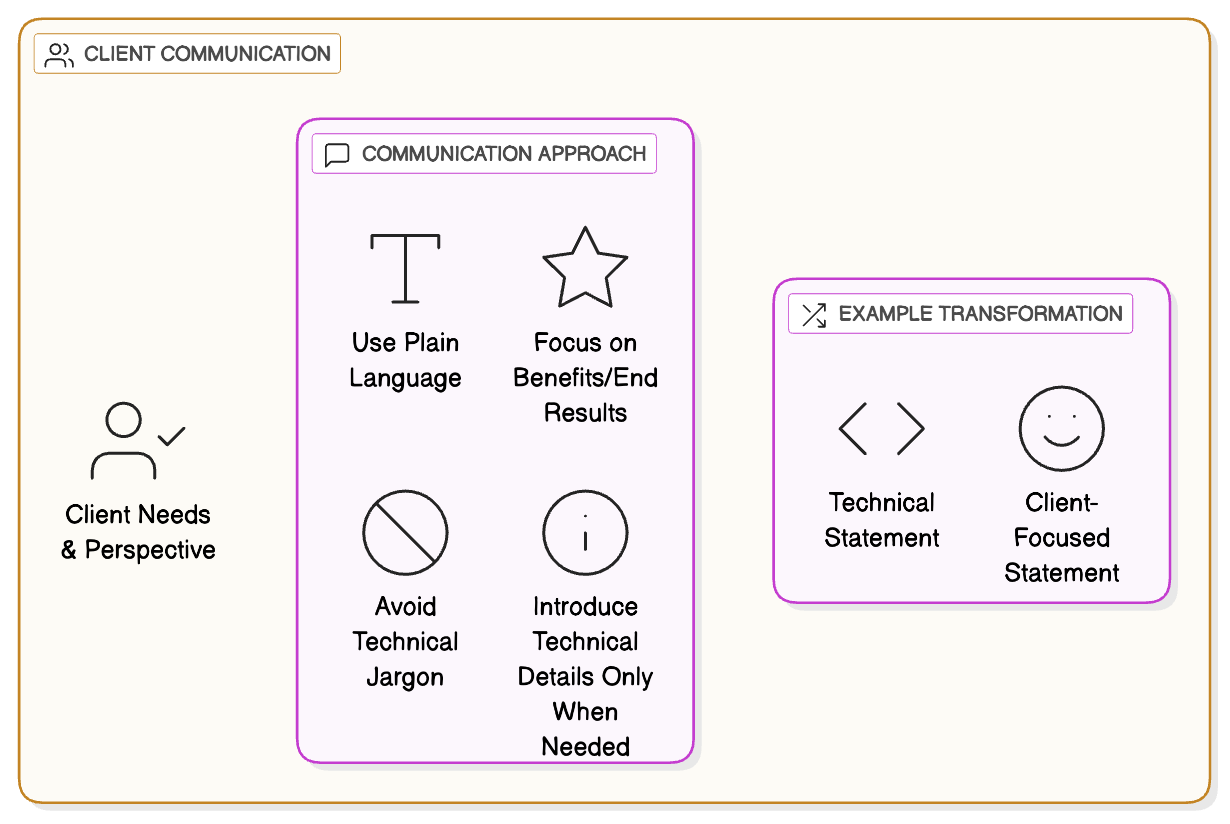How to Talk Technical Stuff with a Non-Technical Audience?
The Communication Iceberg
Today’s topic is slightly different from the usual System Design topics. It’s about communicating your technical ideas and details to a non-technical audience for maximum impact.
Have you ever struggled to explain a tech concept to someone who has never seen a line of code in their life?
Yes, we have all been there at some point or the other.
It may be hard for a new developer to imagine, but a large number of your colleagues are going to come from a non-tech background. And you need to interact with them every now and then. In some roles, this interaction will be extremely important.
However, one thing is certain.
If you want to grow as a developer, you must learn how to talk tech stuff with non-tech colleagues.
Trust me - this is the key to your success, whether you are in an organization or if you are running your own freelance business.
But frankly speaking, it’s not as tough as we make it out to be.
Over the years, I have always relied on what I call the Communication Iceberg to get my ideas across as effectively as possible. The iceberg contains many tools for abstracting the technical stuff while engaging with non-technical folks in what can sometimes be career-defining interactions.
However, it’s important to understand when and how to use these tools. And that’s what we will be covering in this post.
For better clarity, I have divided the tips into two categories.
1 - The General Tips
Some things that you must do at a bare minimum while explaining programming concepts to a non-tech audience:
Use analogies - Instead of using terms like servers and requests, try relating them to real-world examples such as waiters and orders in a restaurant.
Avoid acronyms and jargon - Wherever possible, use plain language to explain a concept instead of an acronym or jargon.
Explain stuff visually - Use visual aids such as flowcharts, diagrams or graphs instead of long-winded explanations.
Use storytelling - Everyone loves stories. They are powerful tools to capture the attention of a non-tech audience. For example, instead of saying version control, build a story of a team of developers sharing their code and tracking changes.
Focus on the big picture - Don’t jump into the deep end of a tech concept. Try to start with the big picture and ease your non-tech audience into learning more about complex topics.
Encourage questions - Don’t be a robot while explaining a concept. The more questions you can encourage people to ask, the more you will be able to get them involved and make them understand the topic.
Here’s a diagram that can help you make more sense of these strategies
2 - Role-Specific Tips
The general tips can take you a long way.
But an organization is made up of many roles. People come from different backgrounds. They have different goals to achieve or agendas to pursue depending on their position.
I have experienced that it can be extremely fruitful to understand your audience better and tailor your message accordingly.
Here are a few tips that can help you out with specific roles.
Managers
When you talk to a manager, try to focus on the business impact of your technical work.
Always use data and metrics to push your point rather than plain old conviction.
Instead of saying:
“We need to use this technology because it’s so good and futuristic”
Try proposing:
“By implementing this new technology, we are able to save the company $50,000 in operational costs each quarter, while also increasing our efficiency by 20%. These savings can be reinvested into other areas of the business to drive growth.”
Here’s a more detailed schematic on how you can go about gathering this information by involving various stakeholders.
Sales Team
A sales team is interested in one thing - selling stuff. When communicating with them about your technical work, focus on how it helps them achieve their goals.
Here’s an example:
“Our new software upgrade will enable your sales team to access customer data in real-time, providing them with the insights they need to close deals faster.”
Following this approach directly links your software with their KPI and increases their chances of funding your project.
Clients
Clients are like potential buyers for your technical product. They might be the reason for your product’s existence in the first place.
When communicating with clients, avoid technical jargon and use plain language to explain your work. Focus on the end results and how your work will benefit the client.
Instead of saying:
"We're using AWS Lambda to create serverless functions."
Try saying:
"We're building a system that can handle millions of requests without worrying about server capacity, which means your application will run smoothly with minimal downtime."
Get into the technical jargon after you’ve sold the main benefit, and only when it is really required.
General Audience
As a software developer, you might need to share your knowledge and experience with a hall full of people. In such cases, you can’t automatically count on the audience to know about your area of expertise.
When communicating with colleagues who may not be familiar with your area of expertise, try to use analogies or real-world examples to explain technical concepts.
For example, explaining API security to someone who's not familiar with the area is tough.
Try to create analogies like comparing it to locking your front door to keep burglars out. It's the same idea, but instead of a physical key, you introduce a special code and create a mental picture for your audience.
👉 So, which other tips or strategies will you add to the list?
Shoutout
Here are some interesting articles I’ve read recently:
Use Compound Components React Advanced Pattern For Better Software Design by
What are JSON Web Tokens (JWTs)? by
6 Generative AI Courses to learn LLM, ChatGPT, and LangChain in 2025 by
That’s it for today! ☀️
Enjoyed this issue of the newsletter?
Share with your friends and colleagues.





Loved this. Super relatable.
Most of us (developers) focus so much on writing clean code but forget how important it is to talk about it clearly, especially with folks outside tech.
I like the “Communication Iceberg” analogy. I’ve seen analogies and stories do way more than technical explanations ever could.
One thing I try to do: tie everything back to real outcomes:
- money saved
- speed gained
- risks avoided
That’s what non-tech people actually care about.
Great read, Saurabh.
That's something I actively work on. That's precisely what I mean when I say we need to speak more 'language of business' to my team. I especially appreciated the breakdown of the audience and the specific tips provided for each.